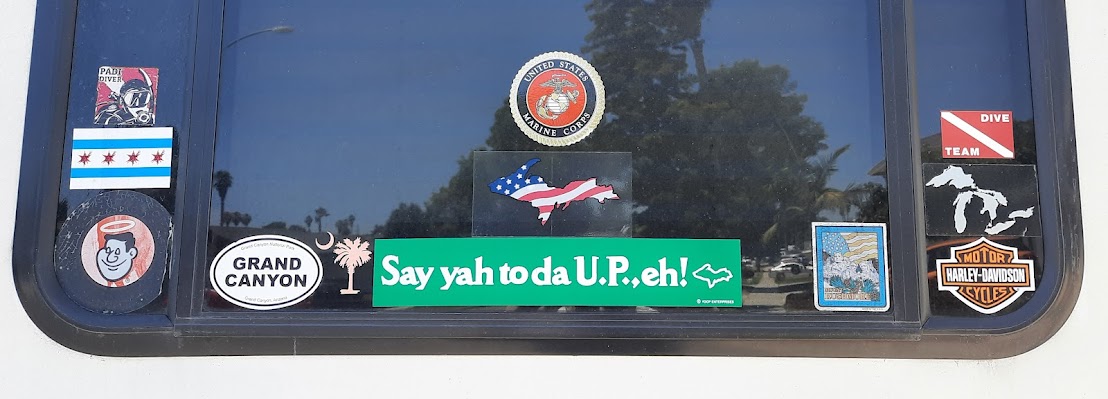Ray Stanton Avery is often credited as the creator of the modern-day sticker, thanks to his invention of the first pressure-sensitive label. Avery would then go on to create the first commercial labels and the bumper sticker was born!
As for customized bumper stickers, credit goes to Forrest P. Gill, who lived in Kansas City, Missouri and in the 1940s took some adhesive-backed paper, a bit of fluorescent paint and combined them to create the first ever bumper sticker (although back then they were known as “bumper strips”!).
Over time, the process of how bumper stickers were made had to be adjusted, as ol’ Gill’s creation was messy and not streamlined as they were handmade.
Using flexography became popular in the '50s, as it allowed printers to pass self-adhesive vinyl through presses for quicker production. By the 1960s however, the General Press was invented by James Black. Shortly after, this became the screen-printing standard and the prominent method for printing stickers.
https://www.carsales.com.au/editorial/details/a-quick-history-of-the-car-bumper-sticker-136853/
The bumper sticker as we know it today can be traced back to a screen printer in Kansas City, Mo. named Forrest P. Gill. In the 1940s, Gill found himself with a surplus of two wartime technologies: adhesive-backed paper and fluorescent paint. He combined the two and the bumper sticker was born. His new creation was a significant improvement over handmade signs that fell off cars or easily wore down.
The first early adopters of bumper stickers were tourist sites. Instead of having a single sign on the side of the road, destinations now had countless ads traveling across the country. Gill’s first large volume request was 25,000 bumper stickers for Marine Gardens in Clearwater, Fl. (The company Gill founded is still around today and still selling bumper stickers.)
Early widespread uses of the advertising bumper sticker were for tourist attractions, such as Marine Gardens, Florida, Seven Falls, Colorado, Meramec Caverns in Missouri, and Lookout Mountain, Tennessee. Another popular advertisement was the "See Rock City" sticker. In the 1940s and 1950s, visitors to the site had a sticker applied to their car, which duplicated the famous signs painted on the roofs of barns throughout the southeastern USA. Tourist attraction staff would circulate through the parking lot, applying the promotional sticker to every car.
The popularity of bumper stickers took a major step forward during the 1952 presidential election between Dwight Eisenhower and Adlai Stevenson. It was the first election to include the use of bumper stickers as advertising materials. They have since been used in every U.S. presidential election.
In 1989, a man with a bumper sticker containing indecent wording was convicted. The man's conviction was reversed in Cunningham v. State (1991). The court referenced the First Amendment, stating "the provision regulating profane words on bumper stickers reaches a substantial amount of constitutionally protected speech and unconstitutionally restricts freedom of expression"
https://magazine.northeast.aaa.com/daily/life/cars-trucks/auto-history/bumper-stickers/
https://en.wikipedia.org/wiki/Bumper_sticker
https://kuscholarworks.ku.edu/handle/1808/9874
It's probably fair to say that the end of the traditional bumper sticker coincided with the beginning of plastic covered bumpers, and the birth of the window suction cup caution signs, like Baby on Board, then the license plate trim ring advertising


Great history! Does anyone remember heavy paperboard bumper advertising? Usually when you were parked at an amusement park in the late 1940's and 1950's, an employee of the park would attach the heavy-duty paper by looping two mires through holes on each end of the horizontal ad, then wrap them around the bumper because bumpers in those days protruded and were spaced beyond the car's body. So, "WE VISITED LAKE GEORGE, NY." "THIS CAR CLIMBED MOUNT (WHATEVER)." "I LOVE THE BLUE RIDGE MOUNTAINS."
ReplyDeletehey! New to me! I'm going to see if I can find some to post! I've never seen or heard of it... must have been the thing bumper stickers evolved from!
DeleteGreat! I found a couple! Thank you Tom!
Delete